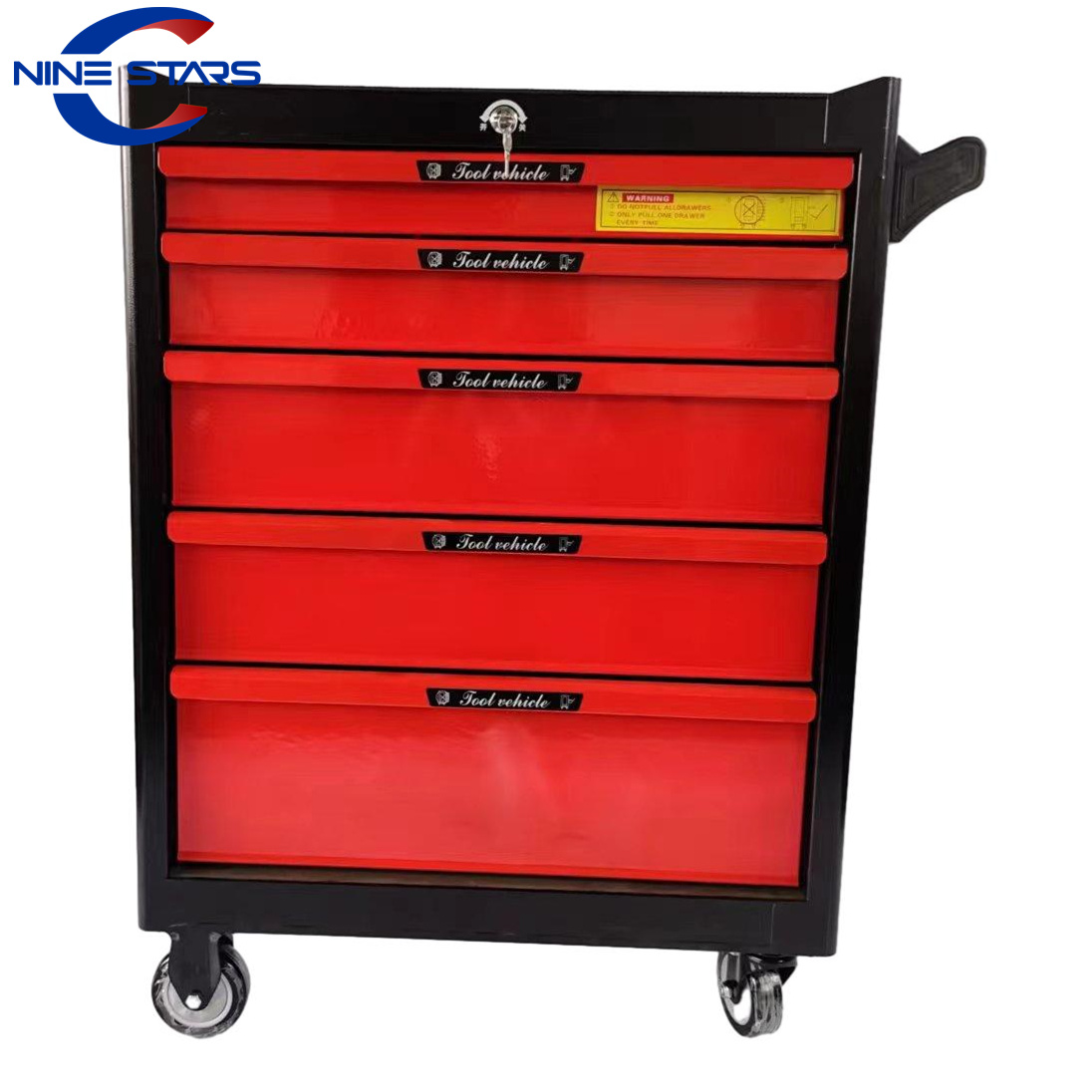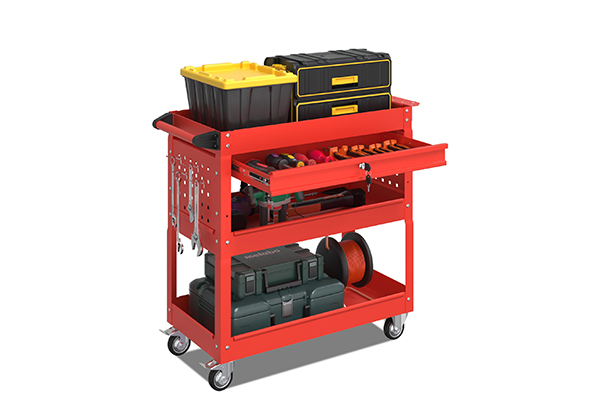Finding the right storage for your valuable tools isn't just about tidiness; it's about efficiency, security, and protecting your investment. Whether you're managing a busy automotive workshop, a construction site, or simply looking for better organization in your garage, a lockable tool cart or rolling tool chest is indispensable. This guide, drawing from my experience as Allen, representing a leading Chinese manufacturer of tool boxes, tool trolleys, and tool cabinets, will walk you through everything you need to know. We'll explore different types, essential features, and crucial buying considerations, especially for business owners like Mark Thompson who value quality and cost-effectiveness when sourcing storage products internationally. Read on to discover how the right tool box tool storage can streamline your workflow and secure your assets.
1. Why is a Lockable Tool Cart Crucial for Professionals and DIY Enthusiasts?
In any environment where tools are used, organization and security are paramount. A lockable tool cart serves as a mobile command center, keeping essential tools and supplies close at hand while protecting them from theft or unauthorized use. For professionals in automotive repair or construction, time is money. Scrambling to find the right wrench or socket wastes valuable minutes. A well-organized tool cart ensures every item has its place, often within clearly labelled drawer units or specific compartment areas. This immediate accessibility significantly boosts productivity.
Furthermore, the lockable feature provides peace of mind, especially on busy job sites or in shared workshop environments. Knowing that your expensive tools are securely stored when you step away prevents loss and deters casual theft. For the serious DIYer involved in home repair or home improvement projects, a lockable tool cart offers a similar blend of convenience and security, transforming a cluttered garage into a functional workbench area. It's more than just storage; it's an investment in efficiency and asset protection. The durability of a quality cart ensures it withstands the rigors of daily use.

2. Exploring the Variety: What Types of Tool Chests and Storage Cabinets Are Available?
The world of tool storage is diverse, catering to different needs and budgets. As manufacturers, we produce a wide array of tool chests and storage cabinets. Common materials include robust iron (often powder-coated for extra durability and corrosion resistance), lightweight yet strong plastics (like reinforced polypropylene), and premium stainless steel for maximum durability and a sleek look. You'll find portable tool box options, multi-layered folding tool boxes (like cantilever style), and larger, stationary tool cabinet units.
Tool chests typically feature multiple drawer units stacked vertically, sometimes designed to sit atop a workbench or a matching rolling cabinet base. Storage cabinets, on the other hand, can range from smaller wall-mounted units to large, freestanding metal storage lockers, often with adjustable shelving alongside or instead of drawers. Consider the number of drawers needed – options range from a compact one drawer tool cart to substantial tool cabinets with 3 drawers, 4-drawer configurations, five drawers, 6 drawers, or even 8 drawers or more, providing ample storage for extensive collections. Our factory produces various styles, including economical tool trolleys for basic needs and more specialized storage systems.
3. How Can a Rolling Tool Cart Boost Efficiency in Your Workspace?
Mobility is a game-changer in dynamic work environments. A rolling tool cart, essentially a tool chest with wheels, allows you to bring your entire toolkit directly to the job, whether it's across the workshop floor or next to a vehicle lift. This eliminates countless trips back and forth to a stationary tool cabinet or workbench, saving significant time and energy. Imagine performing complex repairs or assembly tasks with every necessary tool within arm's reach – that's the power of a good rolling tool cart.
These carts typically feature sturdy caster wheels, often with locking mechanisms on one or two wheels to keep the cart stable when stationary. The combination of drawers, a top tray surface (sometimes with a protective liner), and occasionally side shelves or a pegboard makes them incredibly versatile. A rolling tool cart isn't just a storage solution; it's an efficiency multiplier. It keeps your workspace less cluttered, promotes a smoother workflow, and ultimately helps get jobs done faster, making it ideal for busy garages and workshops. This mobility is a key feature of many storage trolley designs.
4. What Defines a Truly Heavy-Duty Steel Tool Cart?
When procurement officers like Mark Thompson look for storage products, terms like "heavy-duty" often come up. But what does that really mean for a steel tool cart? From our manufacturing perspective, it starts with the gauge of the steel. Thicker steel provides greater strength and durability, allowing the cart to handle significant weight without buckling or warping. Look for steel construction details – quality weld points are crucial for structural integrity, ensuring the frame can resist the stresses of heavy loads and movement.
A heavy-duty cart also features robust components. This includes high-load-capacity caster wheels (often larger diameter for easier rolling over obstacles), reinforced corners, and strong handles. The powder-coated finish isn't just cosmetic; it adds a layer of protection against scratches, chemicals, and rust, contributing to the cart's longevity. Furthermore, the drawer slides should be rated for substantial weight, ensuring they operate smoothly even when fully loaded. A truly heavy-duty tool cart is built to last, offering reliable service in demanding industrial or automotive settings. Its high strength ensures it can handle the toughest jobs.

5. Drawer Deep Dive: Why Do Ball Bearing Slides Matter in a Tool Chest?
The drawers are the heart of any tool chest or tool cabinet. Their smooth and reliable operation is critical for user satisfaction and efficiency. This is where ball bearing slides come in. Unlike simpler friction slides, ball bearing slides use small steel balls rolling within a track system. This significantly reduces friction, allowing drawers to glide open and shut effortlessly, even when heavily loaded with tools. This smooth opening and closing action is a hallmark of a high-quality tool chest.
For someone frequently accessing tools, the difference is night and day. Ball bearing slides provide a feeling of quality and durability. They are less prone to sticking or jamming compared to cheaper alternatives. Many quality drawer units also feature a detent system to prevent them from drifting open accidentally, especially important on a rolling tool cart. When evaluating a tool chest or drawer tool box, pay close attention to the drawer action – it's a key indicator of overall build quality and usability. A good drawer toolbox relies on these smooth mechanisms.
6. Maximizing Organization: Understanding Compartment and Tray Options in a Toolbox
Effective tool storage goes beyond just having drawers; it's about organizing the contents within them. Many tool chests and tool carts come with features designed to maximize storage space and keep tools tidy. Top compartments often feature a hinged lid and provide quick access to frequently used items. These top areas might be designed as a simple open tray or include smaller built-in dividers. Some tool box designs, particularly folding tool boxes or cantilever styles, reveal multiple trays and compartments when opened.
Inside the drawers, liner materials (often foam or rubber) prevent tools from sliding around and protect both the tools and the drawer surface. Some models come with pre-cut foam organizers for specific tool types (like socket sets), while others offer customizable foam or plastic dividers. An organizer tray can often be purchased separately or comes standard in some drawers, perfect for small items like screws, nuts, and bolts. Utilizing these various storage compartment and tray options transforms a simple toolbox into a highly efficient tool organizer or box organizer.
- Top Trays: Good for frequently used items, sometimes with a lid.
- Drawer Liners: Prevent sliding, protect tools (non-slip pads are similar).
- Dividers: Create smaller sections within a drawer.
- Organizer Trays: Ideal for small parts and fasteners (storage bin function).
- Cantilever Trays: Found in folding boxes, offer layered storage.
7. Security Matters: What Should You Look For in a Tool Cabinet Locking System?
For any lockable tool cart or storage cabinet, the effectiveness of its locking system is crucial. A basic lock might deter casual opportunists, but for valuable tool collections, a more robust locking mechanism is needed. Look for cylinder locks, which are common and offer a decent level of security. Some higher-end tool chests use tubular locks, which are generally considered more difficult to pick.
The mechanism itself matters too. A single central lock that secures all drawers simultaneously is convenient. Ensure the lock bars that engage with the drawers are made of strong metal and engage securely. Some systems feature an internal locking mechanism that is less exposed and potentially more tamper-resistant. As manufacturers, we understand the importance of security and often offer different lock options, sometimes even customizable ones, to meet specific client requirements. Always test the lock – it should feel solid and engage smoothly. This is a key aspect of any lockable tool storage cabinet.
8. Is a Modular Tool Box Storage System the Right Choice for You?
Modular tool storage systems have gained popularity for their flexibility. These systems typically consist of individual tool box units of varying sizes (some with drawers, some open totes, some specialized organizers) that can be stacked and locked together. Many modular systems also include a wheeled base (cart or trolley style) allowing the entire stack to become a rolling tool cart. This offers incredible customizable storage options.
The main advantage is adaptability. You can buy only the components you need initially and add more as your tool collection grows or your needs change. You can configure the stack differently for various jobs, taking only the necessary boxes. This makes them ideal for tradespeople who move between sites or for workshops needing flexible storage solutions. However, consider the overall durability and weight capacity of the interlocking mechanisms, especially if you plan on stacking many heavy units. For some users, a traditional integrated tool chest or tool cabinet might offer greater rigidity and simplicity.
9. Sourcing Smart: Key Factors When Buying Storage Products Like Tool Trolleys Overseas
For buyers like Mark Thompson, sourcing tool trolleys, tool cabinets, and tool boxes from countries like China offers significant cost advantages. However, it requires diligence. As Allen, representing a reputable factory, here's what I advise focusing on:
- Quality Inspection: Don't rely solely on photos. Arrange for pre-shipment inspections (either personally or via a third-party service) to verify the steel tool quality, weld integrity, powder-coated finish, drawer operation (ball bearing function), caster quality, and locking mechanism.
- Certifications: Request and verify necessary certifications (e.g., ISO quality management, specific safety standards if applicable). Be wary of fraudulent certificates – cross-reference where possible. Our factory readily provides legitimate documentation for our storage products.
- Communication: Clear and efficient communication is vital. Language barriers can exist, but professional suppliers should have English-speaking sales representatives. Look for responsiveness and clarity. Video calls can help build rapport and clarify details.
- Logistics & Shipping: Understand Incoterms (FOB, CIF, etc.). Discuss lead times, packaging standards (to prevent damage during transit), and shipping options. Factor potential delays into your planning to avoid missed sales opportunities. Ask about options like free shipping programs, though this is less common in B2B bulk orders.
- Payment Methods: Use secure payment methods. Letters of Credit (L/C) are common for large orders, while Telegraphic Transfers (T/T) often involve partial payment upfront and the balance upon shipment confirmation. Discuss terms clearly.
- Supplier Reputation: Research potential suppliers. Look for established factories with multiple production lines (like our 7 lines), check online reviews or industry directories, and ask for references if possible. Attending exhibitions remains a great way to meet suppliers face-to-face.
Choosing the right overseas partner involves balancing cost with reliability. A slightly higher price from a proven, communicative supplier with verifiable quality often prevents costly problems down the line. We pride ourselves on being such a partner, offering high-quality, compliant storage systems like our popular 5 Drawer Tool Cabinet Mobile Tool Cart.
10. Maintaining Your Investment: Tips for Caring for Your Tool Cart and Tool Cabinet
A quality tool cart or tool cabinet is a long-term investment. Proper care ensures it continues to function well and look professional for years. Regularly wipe down surfaces, especially the top tray and drawer fronts, to remove grease, dirt, and spills. Use mild cleaners; harsh chemicals could damage the powder-coated finish. Periodically check and tighten any bolts or screws, especially on handles and caster mounts.
Lubricate the ball bearing drawer slides occasionally with a suitable lubricant (like silicone spray) to maintain smooth operation. Clean the caster wheels to remove debris that could impede rolling. If your drawers have liners, take them out periodically to clean underneath. For lockable units, keep the locking mechanism clean and apply a graphite lubricant if needed. Proper maintenance not only extends the life of your storage tool but also ensures it remains a safe and efficient part of your workspace, whether it's for professional use or DIY projects. Consider also our range of individual sockets like the 1/2 Silver Socket Set or specialized tools like the Allen Wrench Set which also benefit from proper storage.
Key Takeaways:
- Security & Organization: A lockable tool cart or tool chest is essential for protecting tools and boosting workshop efficiency.
- Variety Exists: Choose from various materials (steel, plastic, stainless steel) and configurations (tool box, tool trolley, tool cabinet, folding tool boxes) to suit your needs. Look for heavy-duty steel construction for demanding environments.
- Mobility Matters: A rolling tool cart with quality caster wheels saves time and effort by bringing tools directly to the job.
- Drawer Quality: Smooth ball bearing slides are crucial for effortless access to tools in your drawer tool box.
- Features Enhance Use: Look for useful features like top trays, drawer liners, compartments, and robust locking systems. Modular systems offer flexibility.
- Smart Sourcing: When buying overseas, prioritize quality inspection, verified certifications, clear communication, and reliable logistics. Choose reputable manufacturers.
- Maintenance: Regular cleaning and basic maintenance will significantly extend the life and performance of your tool storage cabinet or cart.
Investing in the right tool storage solution is investing in your productivity and the security of your valuable tools. Whether you need a compact toolbox or a large 8-drawer tool cabinet, understanding the options and key features will help you make the best choice for your needs. Enjoy free shipping may be available from some retailers (shop wayfair or others), but for bulk B2B orders, focus on the total landed cost and supplier reliability.
Post time: 04-15-2025



